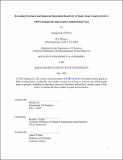Revealing Structural and Spin-state Dependent Reactivity of Single Atom Catalysts (SACs) with Systematically Improvable Computational Tools
Author(s)
Jia, Haojun (贾皓钧)
DownloadThesis PDF (14.26Mb)
Advisor
Kulik, Heather J.
Terms of use
Metadata
Show full item recordAbstract
Efficient catalysts are essential for advancing energy conversion and storage technologies, particularly for challenging reactions such as methane-to-methanol conversion and the oxygen reduction reaction (ORR) important for fuel cells. Single-atom catalysts (SACs), particularly doped graphitic catalysts, have emerged as a promising class of materials. SACs combine the advantages of homogeneous and heterogeneous catalysts, offering tunable active sites and scalability. However, understanding the relationship between the structure of SAC active sites and their reactivity remains challenging due to the limitations of experimental characterizations. Computational modeling provides atomic-level insights into SAC active site configurations and the impact of the metal's local environment on their properties and catalytic activity. This thesis presents a combined effort utilizing computational methods to explore the design and optimization of SACs for methane-to-methanol conversion and the ORR.
In this thesis, we use range-separated hybrid density functional theory (DFT) to compare the energetics and structure of the direct metal-coordinating environment in the presence of 2p (i.e., N or O) and 3p (i.e., P or S) dopants and with increasing finite graphene model flake size to mimic differences in local rigidity. While metal–ligand bond lengths in SACs are significantly shorter than those in transition metal complexes, they remain longer than SAC mimic macrocyclic complexes. Consequently, we observe SACs to simultaneously favor the formation of the metal–oxo while also allowing for methanol release. This reactivity is different from what has been observed for large sets of square planar model homogeneous catalysts. Moreover, modulating the coordination environment near single metal sites by means of codopants, we carry out a large-scale virtual high-throughput screening (VHTS) of transition metal (i.e., Mn, Fe, Co, and Ru) SACs codoped with various elements (i.e., N, O, P, and S) in numerous spin and oxidation (i.e., M(II)/M(III)) states for the challenging conversion of methane to methanol. We identify that the ground-state preference is metal- and oxidation-state-dependent. We observe a weak negative correlation between the oxo formation energy (ΔE(oxo)) and the energy of hydrogen atom transfer (ΔE(HAT)), thanks to the high variability in the coordination environment. Therefore, codoped SACs demonstrate flexible tunability that disrupts linear free energy relationships in a manner similar to that of homogeneous catalysts without losing the scalability of heterogeneous catalysts. Further exploration focuses on codoped Fe and Ru-based SACs for ORR using VHTS and machine learning (ML). The ML models demonstrate superior accuracy in predicting reaction energetics compared to traditional scaling relationships. The findings validate codoping as a powerful strategy for tuning the properties of SACs to achieve enhanced ORR performance. Promising catalyst candidates are proposed for experimental validation, showcasing the potential of SACs in overcoming limitations in catalyst design for challenging reactions and provides valuable insights for the rational design of high-performance ORR catalysts.
Date issued
2024-05Department
Massachusetts Institute of Technology. Department of ChemistryPublisher
Massachusetts Institute of Technology